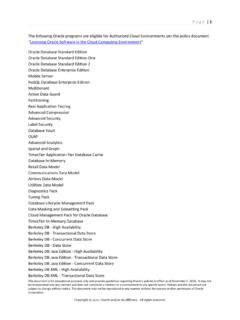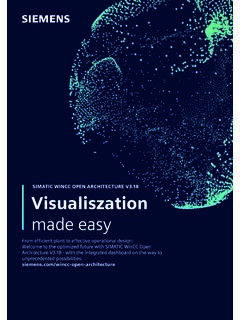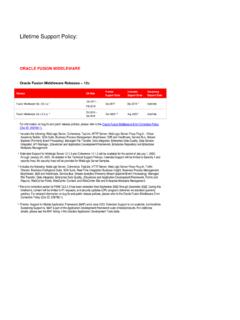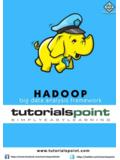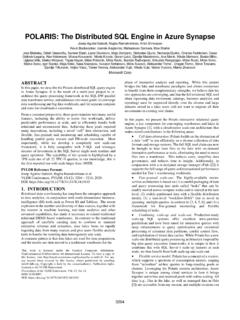Transcription of TOGAF 9 Part 1 Practice Test - WebAgeSolutions.com
1 Page | 1 TOGAF Certification for People TOGAF 9 part 1 Practice Test August 2020 Version The part 1 Practice Test is representative of the content covered in the TOGAF 9 part 1 Examination. It includes question formats found in the actual examination. It also includes questions of varying difficulty. A candidate s performance on this Practice Test does not guarantee similar performance on the actual examination. Page | 2 Copyright Web Age Solutions All rights reserved. No part of this publication may be reproduced, stored in a retrieval system, or transmitted, in any form or by any means, electronic, mechanical, photocopying, recording, or otherwise, without the prior permission of the copyright owner.
2 Boundaryless Information Flow is a trademark and Making Standards Work , The Open Group , TOGAF , UNIX , and the X device are registered trademarks of The Open Group in the United States and other countries. Page | 3 CONTENTS 1 Instructions .. 4 2 Examination .. 4 Page | 4 1 INSTRUCTIONS This is a simple multiple choice test. This test should be taken as a closed book test. There is one correct answer for each question, scoring 1 point. You need to score 24 or more points1 out of a maximum of 40 to pass this test. Please read each question carefully before reading the answer options.
3 Be aware that some questions may seem to have more than one right answer, but you are to look for the one that makes the most sense and is the most correct. 2 EXAMINATION Item 1 Question: Which of the following entities could possibly form an enterprise according to TOGAF ? A. The customers of a local bakery. B. A third-party supplier of fabric supplies to a clothing retail business. C. The Human Resources department of an insurance company. D. Only B and C above. E. A, B and C above. Item 2 Question: Which of the following is a possible definition in TOGAF , according to context, of architecture ? A. An informal description of a system and its components, used to guide further architectural planning, B.
4 A detailed plan of a system at a component level that guides its development. C. A plan for how to operationalize an ICT system that captures its components and their interactions. D. The formal technical design of an ICT system. E. A business process model showing tasks, activities, actors and resources. Item 3 Question: TOGAF defines the development of four key architecture domains. Which of the following is NOT one of these? A. Business B. Security C. Data D. Application E. Technology 1 Note that this pass mark may differ from the live TOGAF 9 part 1 Examination. Consult The Open Group certification web site for the latest information on examination pass marks.
5 Page | 5 Item 4 Question: Which is NOT one of the six parts of the TOGAF standard? A. architecture Development Lifecycle B. Introduction C. architecture Content framework D. architecture Capability framework E. enterprise Continuum and Tools Item 5 Question: Which Phase of the ADM includes identifying key stakeholders who will be involved in your architecture transformation effort? A. Phase A B. Phase B C. Phase C D. Phase D E. Phase E Item 6 Question: What is an architectural work product referred to that comes in one of three types: Catalogue, Matrix or Diagram? A. A Deliverable B. A Building Block C. An Artifact D. A Work Item E. An Architectural Output Item 7 Question: The ADM supports the concept of iteration in which of the following ways?
6 A. You can move from one phase to the next following the arrows and completing a full cycle of the ADM as many times as is needed to fully develop your architecture , but you can never go back to a previous phase. B. You can only iterate between the Business, Application, Data and Technology architecture development phases; you must execute the other phases in sequence. C. Once a Phase has been completed you must continue around the ADM until you arrive back at that phase if you want to make additional architectural enhancements. D. You can iterate around the ADM and within a single phase as many times as you like, as well as jumping back to a previously completed phase over and over again.
7 E. You can repeat activities within any phase over and over again and then proceed to the next phase. Page | 6 Item 8 Question: In which Phases of the ADM are impacts across the architecture landscape resolved? A. Phases A, B and C. B. Phases P, A, B and C. C. Phases B, C and D. D. Phases B, C, D and E. E. Phases E and F. Item 9 Question: When executing the ADM, when should you consider the re-use of architectural artifacts stored in the architecture Repository? A. In Phase A, when determining the architectural vision. B. When executing Requirements Management you need to consider which artifacts are available for the phase that feeds into this.
8 C. At relevant places throughout the ADM, there are reminders to consider which architecture assets from the architecture Repository you should use. D. In every phase, you need to consider re-using existing artifacts. E. You only need to consider these during Phases B, C and D since this is when you are defining new architectures. Item 10 Question: Which of the following statements is NOT true with respect to the enterprise Continuum? A. The enterprise Continuum is a way of classifying contextual assets used to develop architectures such as policies and standards. B. The enterprise continuum is actively used during the execution of the ADM. C.
9 The enterprise Continuum can be used to classify solutions (as opposed to descriptions or specifications of solutions). D. The enterprise Continuum contains two specializations, namely the architecture and Solutions continuums. E. The enterprise Continuum evolve from Foundation Architectures to Organisation-specific Architectures. Item 11 Question: Which of the following should be classified as a Foundational Solution within the Solutions Continuum? A. An enterprise management system product B. A foundational structure for organizing IT operations such as ITIL C. A financial management tool such as oracle Financials Cloud. D. The internal onboarding process for a state or provincial government.
10 E. A Customer Relationship Management tool such as Salesforce. Page | 7 Item 12 Question: Which of the following statements most accurately describes the relationship between the enterprise Continuum and the architecture Repository in TOGAF ? A. They are not directly related. B. The architecture Repository is a model for a logical instance of the enterprise Continuum. C. The architecture Repository is structured according to the enterprise Continuum. D. The architecture Repository is a model for a physical instance of the enterprise Continuum. E. The enterprise Continuum classifies the architecture Metamodel within the architecture Repository. Item 13 Question: To manage the content of the enterprise Continuum we need tools in order to: A.
